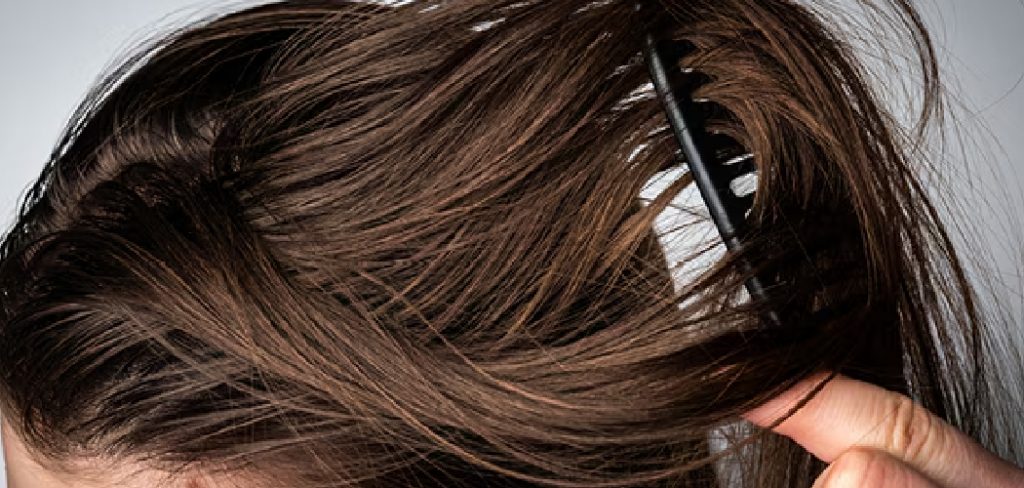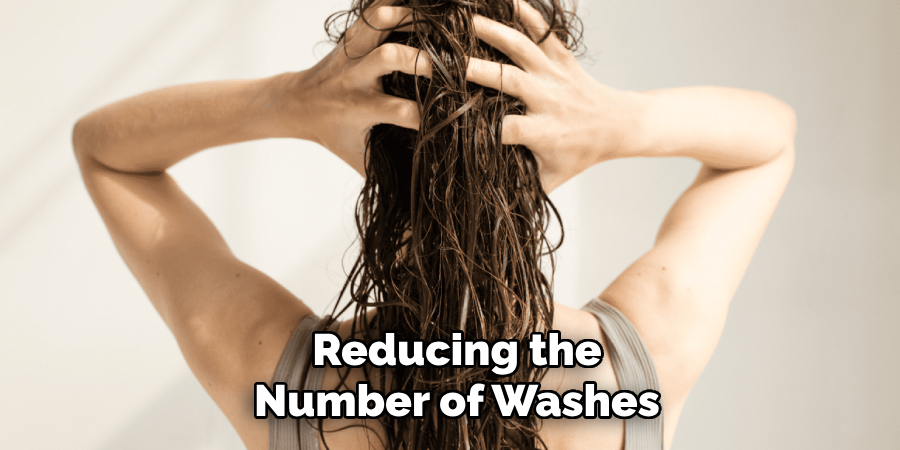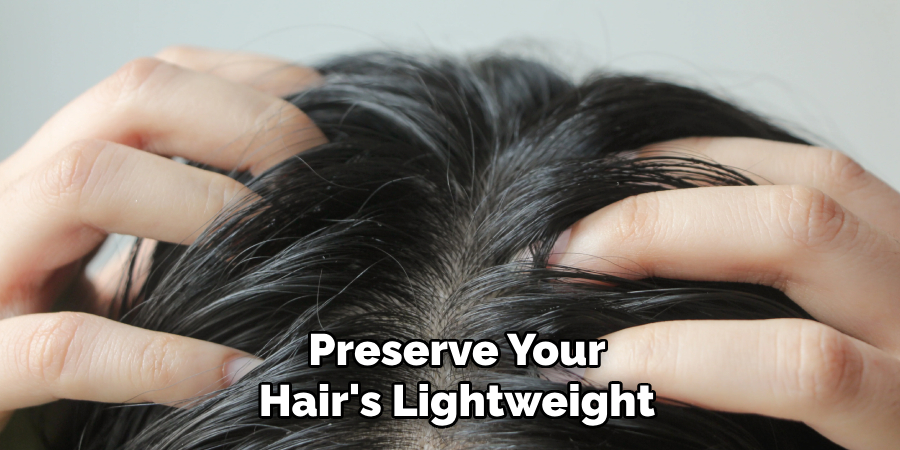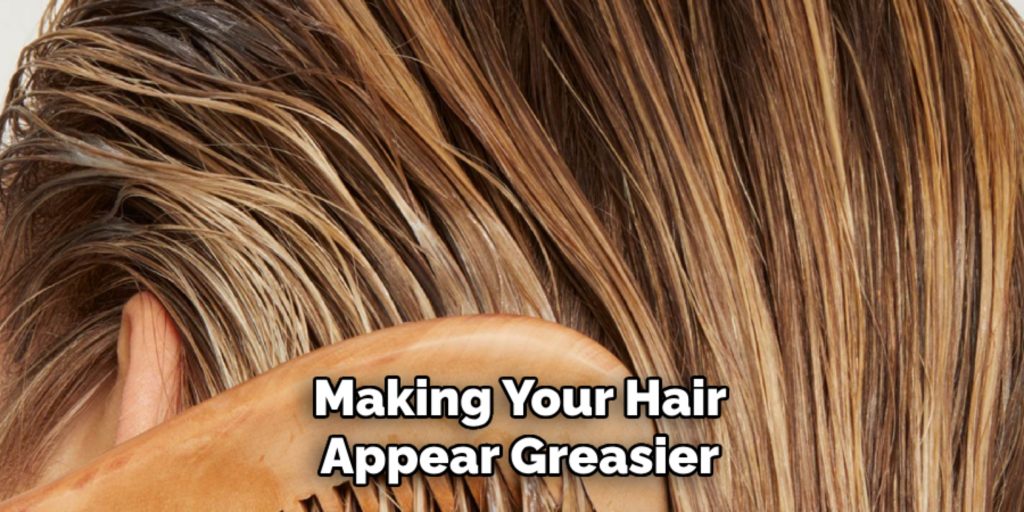Are you tired of dealing with greasy hair that looks unwashed even after a shower? Excess oil production in the scalp can make your hair look flat and lifeless, making it difficult to style. However, there are simple steps you can take to combat oily hair and achieve a fresh and healthy look.

Oily hair can be a frustrating problem, leaving your locks greasy and flat. It often results from the scalp’s overproduction of sebum, which can influence genetics, hormones, and poor hair care habits. Fortunately, there are several strategies you can adopt to manage and reduce oiliness, ensuring your hair stays fresh and vibrant.
This guide on how to make my hair less oily, provides practical tips and effective solutions to help you achieve the perfect balance, leaving you with healthy and less oily hair.
What Will You Need?
- A gentle, clarifying shampoo
- An oil-free conditioner
- Dry shampoo
- Apple cider vinegar
- A boar bristle brush
Once you have these essential items, follow the steps below to combat oily hair and enjoy a clean and fresh head of hair.
10 Easy Steps on How to Make My Hair Less Oily
Step 1: Wash Your Hair Less Frequently
It might seem counterintuitive, but washing your hair too often can exacerbate oiliness. Frequent washing strips your scalp of its natural oils, prompting it to produce even more sebum to compensate. Reducing the number of washes allows your scalp to restore its natural oil balance.

Aim to wash your hair every two to three days, gradually extending the time between washes as your scalp adjusts. You can use dry shampoo between washes to absorb excess oil and refresh your hair. As your scalp becomes accustomed to the new routine, it may produce less oil over time, resulting in healthier and less greasy hair.
Step 2: Use a Gentle Shampoo
Choose a gentle, sulfate-free clarifying shampoo to cleanse your hair without stripping away its essential oils. These shampoos are designed to break down excess oil and buildup, leaving your scalp clean and refreshed while maintaining hair health.
Look for products labeled as “gentle” or “for oily hair” to ensure they are formulated for your needs. When washing, focus on massaging the shampoo into your scalp with your fingertips to cleanse the roots, where oil accumulates properly, and rinse thoroughly. Avoid using hot water, which can overstimulate the sebaceous glands and increase oil production.
Step 3: Condition Only the Ends
Apply conditioner sparingly and only to the ends of your hair, avoiding the scalp and roots. This technique ensures that your hair remains moisturized without adding unnecessary oil to areas already prone to greasiness. Opt for an oil-free conditioner that provides hydration without weighing your hair down.
By focusing on the ends, you preserve your hair’s lightweight and voluminous look, effectively managing the oiliness while keeping the rest of your hair healthy and shiny. Rinse thoroughly with cool or lukewarm water to seal the hair cuticles and enhance shine.

Step 4: Try Apple Cider Vinegar Rinses
Apple cider vinegar can be a powerful tool in controlling oily hair. Its acidic nature helps balance the pH level of your scalp, which can reduce excess oil production. Mix one part apple cider vinegar with two parts water and use this mixture as a rinse after shampooing your hair.
Pour it over your scalp and hair, leave it for a few minutes, and then rinse it out with cool water. This simple remedy can help remove product buildup, leaving your hair looking fresh and shiny. Adding apple cider vinegar rinses to your routine once or twice a week can contribute to healthier, less oily hair.
Step 5: Use Dry Shampoo Sparingly
Dry shampoo can be a lifesaver when you’re in between washes and need to control excess oil. It works by absorbing oil and adding volume to your hair, making it look cleaner. However, overuse of dry shampoo can lead to product buildup, which might clog hair follicles and exacerbate oil production.
To use dry shampoo effectively, spray it lightly onto the roots of your hair from a distance of around 6 inches, then allow it to sit for a few minutes. Gently massage your scalp with your fingertips to distribute the product, and brush through for an even finish. Limit dry shampoo to once or twice a week to avoid buildup and maintain healthy hair.
Step 6: Brush with a Boar Bristle Brush
Using a boar bristle brush can help distribute the natural oils from your scalp throughout the length of your hair. These brushes effectively pick up and move sebum away from the roots, ensuring your hair appears less greasy and more balanced.
Start by brushing at your scalp and gently work your way down to the ends to coat each strand of hair with natural oils evenly. This helps reduce oiliness at the roots and adds a natural shine to your hair. Incorporate brushing with a boar bristle brush into your daily routine for best results, but be sure to clean your brush regularly to prevent oil and dirt buildup.
Step 7: Avoid Touching Your Hair
Frequently touching your hair can transfer oils and dirt from your hands to your strands, exacerbating the oily appearance. Minimizing how often you handle your hair throughout the day can help reduce the buildup of excess oil. Keep your hair styled and resist the urge to adjust it constantly.

Additionally, tying your hair back or styling it to keep it out of your face can also help prevent oil transfer and keep your hair looking fresh. Being mindful of these habits can make a noticeable difference in managing oil levels and maintaining a clean, vibrant look.
Step 8: Be Mindful of Your Diet
Your diet can play a role in managing oily hair. Consuming a balanced diet rich in vitamins and minerals can aid in regulating sebum production and overall scalp health. Foods high in omega-3 fatty acids, such as fish, flaxseeds, and plenty of fresh fruits and vegetables, can support healthier hair and scalp conditions.
Avoid excessive sugar, processed foods, and greasy items, as these can contribute to increased oil production. Staying hydrated by drinking plenty of water is also crucial, as it helps maintain the balance of oils in your body, including on your scalp. By being conscious of your dietary choices, you can support your efforts in reducing hair oiliness.
Step 9: Limit Heat Styling
Excessive heat from styling tools like hairdryers, straighteners, and curling irons can trigger your scalp to produce more oil as a protective mechanism. Avoid using heat styling tools or use them on a lower heat setting to prevent stimulating your scalp’s oil glands. Whenever possible, allow your hair to air dry naturally.
If you must use heat, always apply a heat protectant spray to safeguard your hair from damage. By reducing reliance on heat styling, you can help keep oil production in check while maintaining the health and strength of your hair.
Step 10: Choose Hair-Friendly Products
Selecting the right hair care products is essential in managing oily hair. Opt for lightweight, non-comedogenic products that won’t clog your pores or add extra oil to your scalp. Look for shampoos and conditioners specifically designed for oily hair or those labeled as “clarifying” to remove excess oil and product buildup effectively.
Ingredients like tea tree oil, aloe vera, or chamomile can provide soothing properties and help balance oil production. Avoid using heavy styling creams or gels that can weigh down your hair; opt for mousse or lightweight styling sprays. Choosing suitable products tailored to your hair’s needs can support a healthy scalp and manage oiliness more effectively.
With these steps, you can take control of oily hair and maintain a clean, fresh look. By incorporating these tips into your routine, you can effectively manage oil production and keep your hair healthy and vibrant.
5 Things You Should Avoid
- Over-Washing: Washing your hair too frequently can strip it of its natural oils, leading your scalp to produce even more oil to compensate. Aim to wash every other day or a few times weekly to balance oil production.
- Using the Wrong Shampoo: Avoid shampoos containing harsh chemicals or sulfates, as they can irritate the scalp and increase oil production. Instead, opt for gentle, sulfate-free shampoos designed for oily hair.
- Heavy Conditioners: Applying heavy conditioners to your scalp can weigh down your hair and produce excess oil. Focus on conditioning the ends and opt for lighter, leave-in conditioners.
- Touching Your Hair Too Often: Constantly playing with or brushing your hair can transfer oils from your hands and scalp, making your hair appear greasier. Try to minimize unnecessary contact to keep it looking fresh.
- Skipping Heat Protectant: Heat styling tools without protective sprays can cause the scalp to produce more oil reactively. Always use a heat protectant to safeguard your hair and reduce excessive oiliness.

Conclusion
In conclusion, how to make my hair less oily involves a combination of selecting the right products, adjusting hair care routines, and minimizing unnecessary contact.
By washing your hair less frequently and choosing gentle, sulfate-free shampoos, you can prevent oil overproduction.
Focusing conditioner application on the ends of your hair and using lighter products help maintain volume without contributing to oil buildup. Limiting how often you touch your hair and ensuring that you use heat protectants can significantly reduce excess oil.
These changes allow you to achieve a balanced, healthy scalp and maintain fresh-looking hair throughout the day.
About the Author
Jane Hubbard is a passionate beauty expert with a wealth of experience in makeup, hair, and overall beauty techniques. After years of working as a hairdresser specialist, she followed her entrepreneurial spirit and started her own consultancy business.
Jane has always been driven by her desire to help others feel confident in their own skin, and she does this by sharing her knowledge, experiences, and practical beauty tips. Through her consultancy, she empowers individuals to embrace their unique beauty, offering tailored guidance that boosts both self-esteem and personal style.
Professional Focus
- Specializes in makeup, hairstyling, and beauty consulting.
- Provides personalized beauty advice, tips, and techniques to help individuals feel confident in their appearance.
- Dedicated to staying up-to-date with the latest industry trends and developments.
- Passionate about creating a comfortable and empowering experience for every client.
Education History
- University of Craft and Design – Bachelor of Fine Arts (BFA) in Woodworking and Furniture Design
- Woodworking Apprenticeships – Extensive hands-on training with skilled craftsmen to refine carpentry and furniture making techniques
- Online Courses & Masterclasses – Continued education in advanced woodworking techniques, design principles, and specialized tools
Expertise:
- Makeup artistry, hairstyling, and beauty consulting.
- Personalized beauty techniques to enhance confidence and self-expression.
- Educating clients on how to maintain their beauty routines at home.
